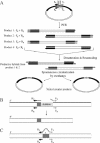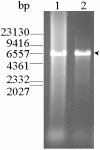Site-directed, Ligase-Independent Mutagenesis (SLIM): a single-tube methodology approaching 100% efficiency in 4 h
- PMID: 15585660
- PMCID: PMC535700
- DOI: 10.1093/nar/gnh172
Site-directed, Ligase-Independent Mutagenesis (SLIM): a single-tube methodology approaching 100% efficiency in 4 h
Abstract
Site-directed, Ligase-Independent Mutagenesis (SLIM) is a novel PCR-mediated mutagenesis approach that can accommodate all three sequence modification types (insertion, deletion and substitution). The method utilizes an inverse PCR amplification of the template by two tailed long primers and two short primers in a single reaction with all steps carried out in one tube. The tailed primers are designed to contain the desired mutation on complementary overhangs at the terminus of PCR products. Upon post-amplification denaturation and re-annealing, heteroduplex formation between the mixed PCR products creates the desired clonable mutated plasmid. The technique is highly robust and suitable for applications in high-throughput gene engineering and library constructions. In this study, SLIM was employed to create sequence insertions, deletion and substitution within bacteriophage T7 gene 5. The overall efficiency for obtaining the desired product was >95%.
Figures


References
-
- Braman J. (ed.) (2002) In Vitro Mutagenesis Protocols, 2nd edn. Humana Press, Totowa, NJ.
-
- Ishii T.M., Zerr,P., Xia,X.M., Bond,C.T., Maylie,J. and Adelman,J.P. (1998) Site-directed mutagenesis. Meth. Enzymol., 293, 53–71. - PubMed
Publication types
MeSH terms
Substances
LinkOut - more resources
Full Text Sources
Other Literature Sources
Research Materials

